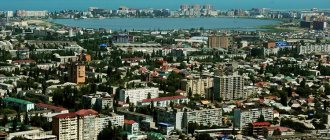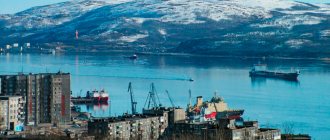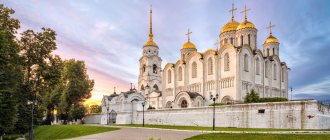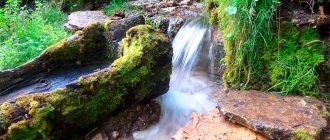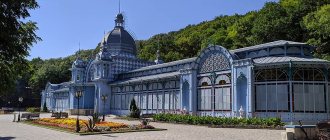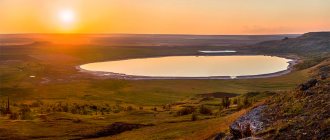Tver
The regional center boasts a large number of attractions: from the travel palace, built for Catherine II and now an art gallery, to the Starovolzhsky Bridge, the city garden, the Nativity Cathedral and the St. Catherine's Convent.
There are also unusual museums in Tver, for example, the Goat Museum and the Plyushkin Museum. And in the city there is one of the places of pilgrimage for chanson lovers - a monument to the cult performer Mikhail Krug. Next to him there are almost always people who want to sit on the bench and take a photo.
Photo: https://ru.m.wikipedia.org
Mineral and holy springs of the area
The Tver region is rich in springs; each district boasts the presence of a dozen clean springs. Many of them are associated with stories of healing from serious illnesses and other miracles.
Kashinsky mineral springs
- Coordinates: 57.363200, 37.601390.
The mineral waters of the city of Kashin are known throughout the country. The Three Springs have long been a place of pilgrimage for believers. Orthodox Christians came to the city to venerate Saint Anna of Kashin, and at the same time collected water from holy springs.
At the beginning of the 19th century, local doctor D. Chernyavsky investigated the healing properties of mineral water and contributed to the creation of the Kashin balneological resort. The springs were soon abandoned, but in 1883 the area found a second life and became a popular resort.
At the beginning of the 19th century, next to the well-equipped sanatorium, a mud bath was erected, in which peat mud treatment was carried out. Some experts noted that Kashinskaya mineral water is richer than Zheleznovodskaya.
During the Soviet years, springs were also used to treat and prevent many diseases. In addition to already known sources, several new wells have appeared. Nowadays, mineral water is used not only in the local sanatorium, but is also bottled and sold in almost all regions of the country.
Mshenskie springs
- Address: s. Mshentsy, Bologovsky district.
Nature has given the ancient village of Mshentsy many cold and clean springs, among which the two largest stand out: the Vmch spring. Paraskeva Fridays and the source of the Kazan Icon of the Mother of God. The first was named after the temple of the same name, the only building that survived from the destroyed monastery. In the second, according to legend, in 1812 the miraculous image of the Blessed Virgin Mary appeared.
At the beginning of 1916, the archaeologist and writer N. Roerich described the springs in his essay “The Undrinking Cup.” Years later, local historian L. Bricker immortalized an excerpt from the work on a tablet, which he later hung on a large stone boulder near the springs. Today the springs are recognized as a natural monument; a wooden chapel rises above one of them.
Red key
- Address: village Kholokholnya.
An unusual source is hidden among the forests in the vicinity of the village of Kholokholnya. The waters of the spring are known for their high iron content, due to which the ground through which the spring flows turns red-brown, as if covered with rust. A stormy stream runs briskly along a steep slope, forms a picturesque waterfall and flows into the Kholokholnya River.
Yeletsky spring
- Address: pos. Elets.
The spring near the city of Yeltsy was named “Zdorovets” and was consecrated in honor of St. Paraskeva Fridays. The first mention of the holy spring dates back to the end of the 15th century. Currently, a high chapel has been erected above the spring, inside of which there is a font for immersion. Outside you can get water from a special tap. The holy spring belongs to the territory of the Zhitenny Monastery.
Maslovskie springs
- Address: village Maslovo.
The springs near the village of Maslovo are popularly called “the springs of living and dead water.” One of the springs was consecrated in honor of St. John the Baptist, with fonts and a small church built above it. The second spring is nicknamed “eye”, as its waters can heal eye diseases.
The water temperature in the two springs does not rise above 4°C all year round. The springs are saturated with minerals and truly have healing properties; many pilgrims claim that they can see better simply by washing their faces with cold water.
Okovetsky key
- Coordinates: village Okovtsy.
A clean, cold spring gushes out of the ground near the village of Okovtsy like a stormy stream and runs down the drain into the nearest river. In Okovtsy, the legend about the origin of the holy spring is passed down from generation to generation.
In 1539, two thieves were hiding in the Okovets forest and suddenly saw an icon of the Holy Cross above a spring. A monk of the Selizharov Monastery named John came to the place of the miraculous phenomenon. Arriving in the village, the monk discovered an icon of the Mother of God with the Child Christ.
Pilgrims flocked to the icons and the spring, many believers were healed of illnesses. Metropolitan Joasaph ordered the construction of two churches nearby: in honor of the Hodegetria icon of the Mother of God and in honor of the Origin of the Honest Trees. During the Soviet years, the icons disappeared without a trace, and the source was desecrated.
After the collapse of the USSR, a new church was erected on the site of the destroyed churches and comfortable wooden baths were installed for immersion in holy water. Every year at the end of July, after the festive liturgy, believers go in procession from the temple to the source.
Torzhok
There are a lot of beautiful churches in this ancient city, for example, the Church of the Entry of the Lord into Jerusalem, the Transfiguration Cathedral, the Church of St. George, etc. In addition, the Boris and Gleb Monastery Complex looks impressive, and lovers of wooden architecture should definitely see the Old Ascension Church.
Torzhok is also famous throughout Russia for gold seamstresses: there is a museum dedicated to them, where you can take part in a master class, and a shop with excellent souvenirs. The city also has its own culinary symbol: Pozharsky chicken cutlets in bread crumbs. They were immortalized by Alexander Sergeevich Pushkin himself in a poetic letter to Sobolevsky. Now Pozharsky cutlets are served in many cafes in Torzhok.
Kalyazin
The bell tower of St. Nicholas Cathedral, surrounded by water, is the main symbol of this small city. It reminds of a sad event in its history: during the construction of the Uglich hydroelectric power station, a significant part of the territory of Kalyazin, where many architectural monuments were located, was simply flooded.
The city has a family tourism facility - Baba Yaga's Estate, where Kikimora Bolotnaya also lives with her. And gourmets can be recommended to visit the snail farm with a tasting room, which was opened on the territory of the local yacht club.
Interesting lakes and waterfalls in the Tver region
The Tver region is a lake region; there are more than 1,700 reservoirs on its territory. Some lakes are especially popular among tourists, fishermen and athletes.
Lake Brosno
- Coordinates: 56.836825, 31.940022.
A small but deep lake is located in the Andreapolsky district. The average depth of the reservoir is about 17 meters, the lowest point is at 42 meters. Popularly called the “Russian Loch Ness,” ancient legends say that a huge monster, similar to the Scottish monster, lurks in its dark waters. Few saw the creature, but many men and women claimed to have heard the dragon's roar and felt the unbearable stench emanating from its mouth.
Modern experts have found a scientific explanation for this myth. Rotting processes are continuously taking place at the bottom, the resulting hydrogen sulfide rushes upward, bubbles of poisonous air come to the surface and, bursting, spread a stench around. The seething water and unpleasant smell frightened local residents and gave rise to stories about a terrible dragon living in the lake. Nevertheless, even today, some tourists come to Brosno in the hope of seeing some fantastic creature on its shores.
Lake Bologoe
- Coordinates: 57.863357, 34.077465.
One of the largest reservoirs in the Tver region is located at the border of the region, near the city of the same name. The lake is relatively shallow, with an average depth of only 3 meters. In the middle of this attraction there is an island on which a hydrogen sulfide spring gushes out like a fountain.
Bologoe is conventionally divided into two parts: the one closer to the city is polluted with waste, the further part is clean and suitable for recreation. At the end of the 19th century, archaeologists excavated a site of primitive man on one of the banks. Later, scientists discovered the skull of an ancient dog that lived in these parts almost 10,000 years ago.
Lake Velikoye
- Coordinates: 57.890755, 33.873286.
A large relict reservoir in the Rameshkovsky district is all that remains of a huge periglacial lake. Velikoye is part of the Orsha-Petrovsky lakes system, consisting of more than 140 reservoirs, and is significantly larger in size than all its counterparts.
The even oval of the lake stretches from north to south; getting to the water is very difficult, since the banks are swampy and densely overgrown with reeds. Nevertheless, all these difficulties do not stop avid fishermen who come to Velikoye every year for a rich catch of fish. Connoisseurs of local swamps also visit the lake to pick cranberries and other edible berries.
Konstantinovsky quarry
- Coordinates: 56.846622, 36.006103.
Located near Tver. In Soviet times, sand was mined in the quarry, but in the 80s, work stopped and the quarry was flooded. Now there is a pond splashing on this place, and the sandy beaches attract local residents and tourists in the summer.
The entry into the water is gentle, so the quarry is suitable for families with children. Vacationers not only swim and sunbathe, but also dive from small islands in the middle of the reservoir, fish, spend the night in tents, go diving and sailing.
Waterfall in the village of Panika
- Coordinates: 57.000978, 35.081362.
The endangered village of Panika in the Torzhok region has practically lost its inhabitants in recent years, but receives hundreds of tourists every year. Near the settlement there are rocks with a small opening in them. In the late 80s, quarrying was going on near the village. One fine day, workers accidentally drilled a well to an underground river, and a stream of water gushed out.
Later it turned out that inside there were karst cavities in which the lake was hidden. The river began to flow through the resulting passage and fall from a height of several meters, running down three stone steps.
The picturesque waterfall attracted tourists and became a local attraction. The area around the waterfall was landscaped, steps were laid to the grotto, and a neat stone bridge appeared at the foot of the rocks. In the hot summer the waterfall dries up, but in the spring it is filled with fresh moisture again.
Toropets
Toropets, located 263 kilometers west of Tver, was founded back in 1074. Here you should definitely see the city ramparts and ancient churches, for example, the Korsun-Bogoroditsky Cathedral. And it was in Toropets that the first monument to a teacher in our country was built. It is very popular among schoolchildren. There is a sign that whoever strokes the foot of the monument will have success in his studies.
Photo: https://commons.wikimedia.org/
oxbow
The iconic landmark of the city is the Holy Dormition Monastery, located on the banks of the Volga. In addition, you should definitely see the 16th-century Vvedenskaya Church and ancient forges here. And it’s just very pleasant to walk around Staritsa, admiring its fantastically beautiful landscapes.
Photo: https://ru.m.wikipedia.org
Outside the city, in the village of Krasnoye, there is the impressive Church of the Transfiguration of the Lord, which is very reminiscent of the Chesme Church in St. Petersburg.
Unusual trees
Ancient forests have been preserved in many areas of the Tver region. Some unique relict trees have received special status and have become popular tourist attractions.
umbrella pine
- Address: village Ivanishchi.
In the village of Ivanishchi there grows a rare and valuable tree from a botanical point of view. The girthless six-meter trunk of the pine tree holds an evergreen canopy of the crown, which, like a huge umbrella, protects visitors from rain and snow. The age of the amazing tree is 300 years.
Kashinskaya pine
- Address: village Sudnikovo.
Another unique pine tree adorns the outskirts of the village of Sudnikovo. Local residents estimate that the tall tree is 800 years old. The pine tree consists of four trunks-branches that are intertwined at the base. Unfortunately, two large branches were “cut down” by lightning; dry stumps stick out from the trunk like snake heads. In 2021, Sudnikovskaya pine represented the Tver region at the all-Russian competition “Russian Tree of the Year”.
Alexander Nevsky Oak
- Address: city. Toropets.
In the ancient city of Toropets there is a tree, unremarkable at first glance, surrounded by a fence. A sign on a pole nearby explains such close attention to the plant: according to legend, the tall oak is a direct descendant of the oak that Prince Alexander Nevsky planted in 1239 in honor of his wedding. Local residents are proud of the landmark and carefully protect it.
Ostashkov
It is in the Ostashkovsky district that the source of the Volga is located: not far from the village of Volgoverkhovye. A small chapel was built next to it.
Photo: https://commons.wikimedia.org
Lake Seliger is another important natural attraction in the vicinity of Ostashkov. It is very popular among outdoor enthusiasts. In addition, on Seliger, on the island of Stolobny and partly on the Svetlitsa peninsula, there is the Nilo-Stolobenskaya hermitage - a beautiful male Orthodox monastery, which was built in memory of the Venerable Nile of Sorsk.
Photo: https://commons.wikimedia.org
Fans of steampunk and retro should check out the Museum of Forgotten Things. And not far from the Village of Khitino, Ostashkovsky district, there is the Pyramid of Hunger, which is visited by those who like to feed on positive energy.
Sights of the Tver region
Sights of the Tver region. The most important and interesting sights of the Tver region - photos and videos, descriptions and reviews, location, websites.
- New Year tours
to Russia - Last minute tours
to Russia
- Ostashkov, st. Uritskogo, 1
the very bestBogoroditsky Zhitenny Monastery
Ostashkov, st. Uritskogo, 1
On the edge of Ostashkov, surrounded by the clear waters of Seliger, the Mother of God Zhitenny Monastery is modestly secluded - an idyllically beautiful and at the same time austere monastery, an ancient architectural monument and the spiritual center of the Tver Upper Volga region.
- Tver, st. Sovetskaya, 26
the very best
Ascension Cathedral in Tver
Tver, st. Sovetskaya, 26
The Ascension Cathedral was built on the site of two wooden churches that appeared in Tver no later than the beginning of the 17th century. During the Polish-Lithuanian invasion, the churches burned down, then they were rebuilt, but the second, Epiphany, was again destroyed by fire.
- Fine
Tver, Sovetskaya st., 3
the very best
Imperial Travel Palace in Tver
Fine
2 reviews
Tver, Sovetskaya st., 3
The Imperial Travel Palace was built on the site of a burnt bishop's house. At first, local authorities thought to restore the house, but later realized that it would be better to place an entire palace here. Moreover, the building was supposed to serve as a resting place for Empress Catherine II.
- Vyshny Volochek, Red Town
the very best
Kazan Monastery in Vyshny Volochyok
Vyshny Volochek, Red Town
The Kazan Convent in Vyshny Volochyok is a unique architectural monument and simply a very interesting place with a lot of remarkable buildings. On its territory there are two ancient cathedrals with exceptional wall paintings, a temple with a bell tower and a hospital monastery building.
- Kalyazin, Uglicheskaya Reservoir
the very best
Bell tower of St. Nicholas Cathedral
Kalyazin, Uglicheskaya Reservoir
The cathedral found itself in the grip of the water element after a flood caused by the construction of a reservoir in Uglich. And if other city buildings have sunk into oblivion forever, the bell tower of St. Nicholas Cathedral still remains afloat, reminding us of the destructive mistakes made in the past.
- Tver, st. Rybatskaya, 11
the very best
Museum named after M. E. Saltykova-Shchedrin in Tver
Tver, st. Rybatskaya, 11
Museum named after M.E. Saltykov-Shchedrin in Tver was opened in 1976 and occupied the building in which the writer lived for a couple of years, holding the position of city vice-governor. An artist from Moscow worked on the creation of the museum: the fact is that there are not many original things of Saltykov-Shchedrin left.
- Tver, Saltykova-Shchedrina, 20
the very best
Iskra Photography Museum
Tver, Saltykova-Shchedrina, 20
Those who are partial to photography simply must visit the Iskra Museum of Photography in Tver. An exhibition of unique (and working!) cameras from the late 19th century to the present day, excursions from a professional photographer and even master classes on film development.
- Tver, Stepan Razin embankment
the very best
Stepan Razin Embankment
Tver, Stepan Razin embankment
The beautiful embankment in Tver is located on the right bank of the Volga. It is named after the Don Cossack Stepan Razin. Back in the mid-18th century, stone houses began to appear on the embankment. They stood close to each other according to the principle of one facade - this style was used in St. Petersburg.
- Torzhok
the very best
Torzhok embankment
Torzhok
Torzhok embankment is a favorite place for walks for city residents, and it is not surprising - the architects and restorers did their job “excellently”, preserving the merchant spirit of the 19th century without any manifestations of pseudo-antique kitsch. It is immediately clear that Tveretskaya Embankment is the calling card of the city.
- fabulous
Tver region, Stolbnoy island
the very best
Nilova Pustyn
fabulous
1 review
Tver region, Stolbnoy island
Nilova Hermitage is a monastery on Stolbny Island, the history of which began in 1528, when the hermit Nil settled on the island. Of greatest interest is the central ensemble of the monastery: the seven-domed Epiphany Cathedral (1821-1833) with a bell tower, from where a magnificent panorama opens.
- Torzhok, st. Staritskaya, 7
the very best
Novotorzhsky Boris and Gleb Monastery
Torzhok, st. Staritskaya, 7
The territory of the Novotorzhsky Boris and Gleb Monastery, one of the oldest Russian Orthodox monasteries, founded around 1038 during the reign of Yaroslav I Vladimirovich, almost at the same time as the Kiev Pechersk Lavra, always makes a strong impression on the guests of Torzhok.
- Tver, st. Sovetskaya, 66
the very best
Tver Cathedral Mosque
Tver, st. Sovetskaya, 66
The Tver Cathedral Mosque looks interesting and memorable, although it is very small. At the time when they decided to build it in 1905, a large building was not required: there were about 300 Muslims in Tver. The mosque was erected in less than a year according to the design of 1844.
- the very best
Tver Kremlin
1 review
In the 12th century, they decided to build the Tver Kremlin to strengthen the city. Considering the constant enmity with Moscow, a reliable fortress came in handy. The length of the Kremlin walls was 1600 meters. One and a half thousand boyars and servants lived on its territory, and another 5 thousand people lived in the district settlements.
- Torzhok
the very best
Vasilevo Estate
Torzhok
About 5 km north of Torzhok there is an architectural ensemble of the 18th century - the Vasilevo estate. It is notable primarily for the ethnographic museum of wooden architecture, opened in 1979, which contains architectural monuments of the 18th and 19th centuries from all over the Tver region.
- Vyshny Volochek, st. Ostashkovskaya
Epiphany Cathedral in Vyshny Volochyok
Vyshny Volochek, st.
Ostashkovskaya The main temple of Vyshny Volochok and the spiritual stronghold of the Tver land, the Epiphany Cathedral is located on a small picturesque island between the Tsna River and the Obvodny Canal. The temple delights visitors with the calm, sublime beauty of Russian churches. - Tver, per. Shevchenko, 16
Botanical Garden of Tver State University
Tver, per.
Shevchenko, 16 A heavenly place almost in the very center of the city - the Botanical Garden of Tver State University. It is located on the banks of the Tvertsa River, not far from the old River Station. Once upon a time, merchants and artisans of the Zavolzhskaya Sloboda lived here. - Kalyazin, st. Engelsa, 1
Church of the Ascension in Kalyazin
Kalyazin, st.
Engelsa, 1 A tour of Kalyazin will be incomplete without visiting the Church of the Ascension. It was built at the end of the 18th century as a cemetery church belonging to St. Nicholas Cathedral. Many tourists who have visited the flooded bell tower of the cathedral note the similarity of these religious buildings. - Ostashkov, Rabochy Gorodok, 1
Ascension Cathedral of the Znamensky Monastery
Ostashkov, Rabochy Gorodok, 1
In the center of the Znamensky Monastery is the Ascension Cathedral - one of the main attractions of Ostashkov, a center of pilgrimage for believers and ordinary tourists who are interested in history, culture and church architecture. - Rzhev, Toropetsky tract, 63
Ascension Cathedral in Rzhev
Rzhev, Toropetsky tract, 63
The Ascension Cathedral was restored from ruins in 1986 on the site of a temple complex from the mid-19th century. That, in turn, was built at the expense of parishioners next to the Kazan cemetery for the miraculous icon of the Kazan Mother of God, which was kept in a dilapidated chapel. - Ostashkov, st. Volodarsky, 5
Resurrection Church in Ostashkov
Ostashkov, st.
Volodarsky, 5 On the picturesque bank of Seliger there is a truly unique ensemble: two stone churches - intricately pretentious and ascetically austere - with two bell towers. One of them stands out impressively with its impressive hipped bell tower and rich decoration - this is the Resurrection Cathedral. - 1
- Next pageNext
The history of the Tver region is very long.
There are many cities, towns and villages here that are famous for something. A dozen and a half of them are officially considered historical; among them, for example, Torzhok, Kashin, Kalyazin, Rzhev, Bezhetsk. There are almost 9.5 thousand officially registered cultural and historical monuments in the entire region alone. And this is not to mention the natural beauty: an abundance of lakes and rivers, the Zavidovo National Park and the Central Forest Reserve. The Christian shrines of the Tver region are so numerous that not a single excursion will allow tourists to see even half of them. In the Ostashkovsky district, for example, there is the famous Nilova Hermitage, an amazing monastery on an island in Lake Seliger. And in Staritsa, on the Volga, there is the Holy Dormition Monastery, founded in the 16th century and revived in the late 1990s.
There are almost 9.5 thousand officially registered cultural and historical monuments in the entire region alone.
There are three branches of the Tver Art Gallery in the Tver region, and each is interesting in its own way. In the village of Krasnaya Nov, a little over 20 km from Tver, there is the Domotkanovo Estate Museum. This memorial art museum is dedicated to Valentin Serov. It was founded in 1965 and occupies the von Derviz estate. One part of the exhibition is dedicated to its history and a specific period of not only the life of the artist, but also other cultural figures of the turn of the 19th and 20th centuries who visited here. The estate has preserved its original interiors and the remains of a beautiful landscaped park on the territory. The second part is given over to art exhibitions.
The second branch of the gallery is located in the village of Emmaus: this is the Vladimir Serov Memorial Art Museum. It was opened in 1980. From its exhibition you can learn more about the life and work of the Soviet painter, famous for his works in the genre of socialist realism. His portraits, drawings, genre paintings, and book illustrations are on display for everyone to see.
The third branch is the center of culture and art at the Chaika dacha. It is located the farthest: about 200 km from Tver, near Udomlya, on the shore of the lake of the same name. The museum occupies a modern wooden building, built in 1913, in which the remarkable master of landscape V. Byalynitsky-Birulya lived. Part of the room is given over to memorial and art exhibitions dedicated not only to Byalynitsky-Birula himself, but also to other painters who are in one way or another connected with these places, such as K. Korovin and I. Levitan. Another part of the museum is dedicated to regular temporary exhibitions of contemporary artists.
In the Ostashkovsky district there is a remarkable place, which is considered the source of the Volga. This is a small spring with a chapel near the Olginsky Monastery.
The Pushkin Ring route passes through the territory of the Tver region. Its duration is about 250 km. Along the way, tourists can explore the places that the great Russian writer visited during his visits to the Tver province (of which there were more than a dozen in his life). Among the objects of the route are the estates of Pushkin’s friends, inns, hotels, churches.
Other museums in the Tver region dedicated to famous figures of Russian culture and art are, for example, the Pushkin Literary and Memorial Museum in Bernovo, the Venetsianov Estate Museum in Safonovo, the S. Lemeshev Museum in Knyazevo and the estate of Akhmatova and Gumilyov Slepnevo.
Vyshny Volochyok
Situated on the Tsna River, the picturesque town is definitely worth a visit. The railway station, built in the 19th century and to this day retaining its original appearance, ancient shopping arcades, the 18th century traveling palace, the Kazan Convent - this is an incomplete list of what is definitely worth seeing in Vyshny Volochyok. By the way, for lovers of the color of their native country, there is a museum “Russian felt boots”.
https://commons.wikimedia.org
Rzhev
This city of military glory pleasantly surprises tourists with a large number of attractions. Among the most impressive of them are the Monument at the mass grave of Soviet soldiers and the Museum of Military History of Rzhev with a diorama “Battle of Rzhev” and an exhibition of military equipment. The historical development of the city is noteworthy; in addition, there are many ancient temples.
Photo: https://ru.wikipedia.org
Bezhetsk
This small ancient city in the northeast of the Tver region will appeal to those who like to take pictures against the backdrop of original attractions. For example, several years ago a monument to the balalaika appeared in Bezhetsk: it was in this city that the musician Andreev was born, who glorified the ancient Russian instrument throughout the world. Near the entrance to the local bus depot there is a monument bus, which has been preserved in excellent condition and is also a popular subject for photographs. The Raspberry Museum is also open in Bezhetsk. Before leaving, you can relax in the picturesque city garden.
Photo: https://ru.wikipedia.org
Mineral springs
In the Tver region there is the resort town of Kashin. The local sanatorium was opened more than 130 years ago. Healing water of high mineralization is extracted from depths from 110 to 960 m. Currently, the balneological health resort has 7 springs.
Once upon a time, mineral waters were actively used to treat patients in the Adreapol region of the region. The old resort is long gone, but local authorities from time to time raise the issue of restoring it. Today, Vysokovsky mineral waters on the border of the Kashinsky district and wells in the sanatoriums “Igumenka” and “Karacharovo” are used for treatment of residents of the region and tourists.
Estate Stepanovskoye-Volosovo
Kimry
The city of Kimry captivates with its ancient wooden buildings, which look very original. In addition, there is a “House of Crafts”, where you can attend interesting master classes on Russian arts and crafts, and the UFO amusement park, beloved by children. And in the village of Privolzhsky, located 15 kilometers from the city, which is considered the birthplace of the Serpent Gorynych, there is a Museum of Reptiles.
Photo: https://commons.wikimedia.org
Ekaterina Koroleva


